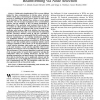Free Online Productivity Tools
i2Speak
i2Symbol
i2OCR
iTex2Img
iWeb2Print
iWeb2Shot
i2Type
iPdf2Split
iPdf2Merge
i2Bopomofo
i2Arabic
i2Style
i2Image
i2PDF
iLatex2Rtf
Sci2ools
100
click to vote
CORR
2010
Springer
2010
Springer
Sidelobe Control in Collaborative Beamforming via Node Selection
Collaborative beamforming (CB) is a power efficient method for data communications in wireless sensor networks (WSNs) which aims at increasing the transmission range in the network by radiating the power from a cluster of sensor nodes in the directions of the intended base stations or access points (BSs/APs). The CB average beampattern shows a deterministic behavior and the mainlobe of the CB sample beampattern is independent of the particular node locations. However, the CB for a cluster of a finite number of collaborative nodes results in a sample beampattern with sidelobes that severely depend on the particular node locations. High level sidelobes can cause unacceptable interference when they occur at directions of unintended BSs/APs. Therefore, sidelobe control in CB has a potential to decrease the interference at unintended BSs/APs and increase the network transmission rate by enabling simultaneous multilink CB. Traditional sidelobe control techniques are proposed for centralized ...
| Added | 09 Dec 2010 |
| Updated | 09 Dec 2010 |
| Type | Journal |
| Year | 2010 |
| Where | CORR |
| Authors | Mohammed F. A. Ahmed, Sergiy A. Vorobyov |
Comments (0)

